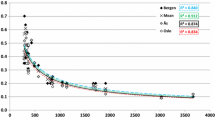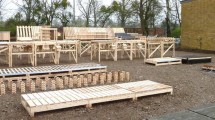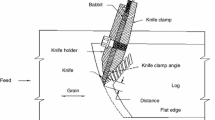Abstract
The present study analyses the moisture performance of nine wood species and wood-based materials determined in various laboratory and field trials to identify the method with the highest predictive power and determine the correlation between respective measurements. The moisture performance of wood and wood-based products has been recognised (besides inherent wood resistance) as the second most important parameter contributing to wood service life in above ground applications. Therefore, it is of great commercial importance to understand this phenomenon. In-service moisture monitoring trials can be unacceptably long, but on the other hand, they provide more realistic test conditions than laboratory tests. However, experiments in laboratory conditions enable a high level of reproducibility and are much faster than in-service tests. In order to assess the correlation between various tests, Pearson product moment correlation coefficients were calculated to determine the level of the strength of the linear relationship between the in-service and laboratory trials. Within this paper, it was attempted to identify laboratory methods suitable for quantification of moisture content during outdoor exposure.




Similar content being viewed by others
References
Awoyemi L, Jones IP (2011) Anatomical explanations for the changes in properties of western red cedar (Thuja plicata) wood during heat treatment. Wood Sci Technol 45:261–267. https://doi.org/10.1007/s00226-010-0315-9
Banks WB (1973) Water uptake by scots pine sapwood, and its restriction by the use of water repellents. Wood Sci Technol 7:271–284. https://doi.org/10.1007/BF00351073
Brischke C, Lampen SC (2014) Resistance based moisture content measurements on native, modified and preservative treated wood. Eur J Wood Prod 72:289–292. https://doi.org/10.1007/s00107-013-0775-3
Brischke C, Rapp AO (2008) Dose-response relationships between wood moisture content, wood temperature and fungal decay determined for 23 European field test sites. Wood Sci Technol 42:507–518. https://doi.org/10.1007/s00226-008-0191-8
Brischke C, Bayerbach R, Otto Rapp A (2006) Decay-influencing factors: a basis for service life prediction of wood and wood-based products. Wood Mater Sci Eng 1:91–107. https://doi.org/10.1080/17480270601019658
Brischke C, Rapp AO, Bayerbach R (2008) Measurement system for long-term recording of wood moisture content with internal conductively glued electrodes. Build Environ 43:1566–1574. https://doi.org/10.1016/j.buildenv.2007.10.002
Brischke C, Meyer L, Bornemann T (2013) The potential of moisture content measurements for testing the durability of timber products. Wood Sci Technol 47:869–886. https://doi.org/10.1007/s00226-013-0548-5
Brischke C, Sachse KA, Welzbacher CR (2014) Modeling the influence of thermal modification on the electrical conductivity of wood. Holzforschung 68:185–193. https://doi.org/10.1515/hf-2013-0041
CEN (2002) EN 84—wood preservatives—accelerated ageing of treated wood prior to biological testing—leaching procedure. European Committee for Standardisation, Brussels, p 7
CEN (2013a) EN 335—durability of wood and wood-based products. Use classes: definitions, application to solid wood and wood-based products. European Committee for Standardisation, Brussels, p 15
CEN (2013b) EN1609—thermal insulating products for building applications—determination of short term water absorption by partial immersion. European Committee for Standardisation, Brussels, p 12
CEN (2015a) EN 252—field test method for determining the relative protective effectiveness of a wood preservative in ground contact. European Committee for Standardisation, Brussels, p 27
CEN (2015b) EN 16818 Durability of wood and wood-based products—moisture dynamics of wood and wood-based products. European Committee for Standardisation, Brussels, p 13
Engelund ET, Thygesen LG, Svensson S, Hill CAS (2013) A critical discussion of the physics of wood-water interactions. Wood Sci Technol 47:141–161. https://doi.org/10.1007/s00226-012-0514-7
Esteves BM, Pereira HM (2009) Wood modification by heat treatment: a review. BioResources 4:370–404. https://doi.org/10.15376/biores.4.1.370-404
Esteves BM, Domingos IJ, Pereira HM (2008) Pine wood modification by heat treatment in air. BioResources 3:142–154. https://doi.org/10.15376/biores.3.1.142-154
Feist WC (1990) Outdoor Wood Weathering and Protection. In: Rowell RM, Barbour RJ (eds) Archaeological wood properties, chemistry, and preservation. American Chemical Society, Washington DC, pp 263–298
Humar M, Kržišnik D, Lesar B et al (2017) Thermal modification of wax-impregnated wood to enhance its physical, mechanical, and biological properties. Holzforschung 71:57–64. https://doi.org/10.1515/hf-2016-0063
Kim JS, Gao J, Daniel GF (2015) Ultrastructure and immunocytochemistry of degradation in spruce and ash sapwood by the brown rot fungus Postia placenta: characterization of incipient stages of decay and variation indecayprocess. Int Biodeterior Biodegrad 103:161–178. https://doi.org/10.1016/j.ibiod.2015.05.005
Kúdela J (2014) Wetting of wood surface by a liquids of a different polarity. Wood Res 59:11–24
Kúdela J, Wesserle F, Bakša J (2015) Influence of moisture content of beech wood on wetting and surface free energy. Acta Fac Xylologiae Zvolen 57:25–35
Kúdela J, Štrbová M, Jaš (2017) Influence of accelerated ageing on morphology and wetting on wood surface treated with a modified water-based coating system. Acta Fac Xylologiae Zvolen 59:27–39. https://doi.org/10.17423/afx.2017.59.1.03
Lesar B, Humar M (2011) Use of wax emulsions for improvement of wood durability and sorption properties. Eur J Wood Prod 69:231–238. https://doi.org/10.1007/s00107-010-0425-y
Lesar B, Pohleven F, Humar M (2009) Use of wax emulsions for upgrading of wood properties. In: Proceedings IRG Annual Meeting, Stockholm, Sweden, Document No.: IRG/WP 09-40451, p 8
Metsä-Kortelainen S, Antikainen T, Viitaniemi P (2006) The water absorption of sapwood and heartwood of Scots pine and Norway spruce heat-treated at 170 °C, 190 °C, 210 °C and 230 °C. Holz Roh- Werkst 64:192–197. https://doi.org/10.1007/s00107-005-0063-y
Meyer L, Brischke C (2015) Interpretation of moisture monitoring data—relevance of moisture content thresholds for fungal decay relevance of moisture content thresholds for fungal decay. In: Proceedings IRG Annual Meeting, Stockholm, Sweden, Document No.: IRG/WP 15-10839, p 24
Meyer L, Brischke C, Preston A (2016) Testing the durability of timber above ground: a review on methodology. Wood Mater Sci Eng 11:283–304. https://doi.org/10.1080/17480272.2014.983163
Meyer-Veltrup L, Brischke C, Alfredsen G et al (2017) The combined effect of wetting ability and durability on outdoor performance of wood: development and verification of a new prediction approach. Wood Sci Technol 51:615–637. https://doi.org/10.1007/s00226-017-0893-x
Otten KA, Brischke C, Meyer C (2017) Material moisture content of wood and cement mortars—electrical resistance-based measurements in the high ohmic range. Constr Build Mater 153:640
Rapp AO (2004) Course of moisture content and Moisture Risk Index of coated and uncoated wood. In: Proceedings of the Final European Seminar on “High Performance Wood Coatings Exterior and Interior Performance”. Paris, France, p 19
Rapp AO, Peek R-D, Sailer M (2000) Modelling the moisture induced risk of decay for treated and untreated wood above ground. Holzforschung 54:111–118
Rémond R, Passard J, Perré P (2007) The effect of temperature and moisture content on the mechanical behaviour of wood: a comprehensive model applied to drying and bending. Eur J Mech 26:558–572. https://doi.org/10.1016/j.euromechsol.2006.09.008
Rep G, Pohleven F (2001) Wood modification—A promising method for wood preservation. Wood Constr Ind Tradit Futur 52:71–76
Rep G, Pohleven F, Bučar B (2004) Characteristics of thermally modified wood in vacuum. In: Proceedings IRG Annual Meeting, Stockholm, Sweden, Document No.: IRG/WP 04-40287, p 9
Rowell RM, Banks WB (1985) Water repellency and dimensional stability of wood. Gen. Tech. Rep. FPL-50. US Department of Agriculture, Forest Service, Forest Products Laboratory, Madison, p 24
Skaar C (1988) Wood–water relations, 1st edn. Springer-Verlag, Berlin Heidelberg
Thybring EE, Kymäläinen M, Rautkari L (2018a) Experimental techniques for characterising water in wood covering the range from dry to fully water-saturated. Wood Sci Technol 52:297–329. https://doi.org/10.1007/s00226-017-0977-7
Thybring EE, Kymäläinen M, Rautkari L (2018b) Moisture in modified wood and its relevance for fungal decay. iForest 11:418–422. https://doi.org/10.3832/ifor2406-011
Time B (1998) Hygroscopic Moisture Transport in Wood. PhD Thesis, Norwegian University of Science and Technology
Van Den Bulcke J, Van Acker J, De Smet J (2009) An experimental set-up for real-time continuous moisture measurements of plywood exposed to outdoor climate. Build Environ 44:2368–2377. https://doi.org/10.1016/j.buildenv.2009.03.021
Wang JY, Cooper PA (2005) Effect of oil type, temperature and time on moisture properties of hot oil-treated wood. Holz Roh- Werkst 63:417–422. https://doi.org/10.1007/s00107-005-0033-4
Willems W (2014) The water vapor sorption mechanism and its hysteresis in wood: the water/void mixture postulate. Wood Sci Technol 48:499–518. https://doi.org/10.1007/s00226-014-0617-4
Winandy JE, Morrell JJ (2017) Improving the utility, performance, and durability of wood- and bio-based composites. Ann For Sci 74:25. https://doi.org/10.1007/s13595-017-0625-2
Zhao T, Jiang L (2018) Contact angle measurement of natural materials. Colloids Surf B Biointerfaces 161:324–330. https://doi.org/10.1016/j.colsurfb.2017.10.056
Acknowledgements
The authors acknowledge the support of the Slovenian Research Agency within the framework of projects L4-5517, L4-7547, program P4-0015 and the infrastructural centre (IC LES PST 0481-09). Part of the research was also supported by the project: Sustainable and innovative construction of smart buildings—TIGR4smart (C3330-16-529003). We want to acknowledge Dr Dennis Jones for language editing.
Author information
Authors and Affiliations
Corresponding author
Ethics declarations
Conflict of interest
The authors, Davor Kržišnik, Boštjan Lesar, Nejc Thaler, Jože Planinšič, Miha Humar, declares that there is no conflict of interests associated with the publication of respective manuscript entitled: a study of moisture performance of wood determined in laboratory and field trials, submitted for publication in Wood Science and Technology.
Additional information
Publisher's Note
Springer Nature remains neutral with regard to jurisdictional claims in published maps and institutional affiliations.
Rights and permissions
About this article
Cite this article
Kržišnik, D., Lesar, B., Thaler, N. et al. A study on the moisture performance of wood determined in laboratory and field trials. Eur. J. Wood Prod. 78, 219–235 (2020). https://doi.org/10.1007/s00107-020-01506-z
Received:
Published:
Issue Date:
DOI: https://doi.org/10.1007/s00107-020-01506-z




